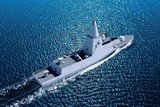German Type 42 SIGINT vessel moves forward with keel laying
An author's impression of how the Type 424 vessels will look in service. (Image: German MoD)
The first of Germany’s new Type 424 SIGINT vessels has had its keel laid at the Wolgast Peene shipyard in Mecklenburg-Vorpommern, Germany.
The three Type 424 vessels are scheduled to replace the ageing Type 423 Oste-class vessels, the Oste, Oker, and Alster, as they are commissioned, at a programme cost of €3.3 billion (US$3.5 billion).
Commissioning of the new vessels is expected between 2029 and 2031, along with the build and operation of a training and reference facility for the vessels. That training centre is scheduled to be completed in 2027, giving users time to get up to speed in the operation of the new vessels before they are brought into service.
Related Articles
Steel cutting begins on German Type 424 SIGINT ships
NATO to strengthen its Baltic Sea presence after new cable cutting incident
Latest undersea cable damage incident investigated in Baltic Sea
NVL was contracted to build the three new SIGINT vessels in 2023, and the steel-cutting ceremony for the first vessel was held in late November 2024.
Among those at the keel-laying ceremony was the Inspector of the Cyber and Information Space, Vice Admiral Thomas Daum, who emphasised the strategic importance of the future units for Germany's maritime security architecture.
“Our fleet service boats in particular, driven by the German Navy and operated in reconnaissance by soldiers of the Cyber and Information Space Service, are a highly effective, indispensable strategic reconnaissance tool for war-ready armed forces. I am therefore delighted about the keel-laying of the first fleet service boat of class 424,” said the Daum.
According to the Bundeswehr, the new vessels will be equipped with advanced surface and underwater reconnaissance components as well as technology that allows them command and control capabilities and the likes of low-noise propulsion systems.
The Type 424 service boats will be around 130 meters in length and will serve as reconnaissance platforms for sea-based intelligence gathering.
Particularly in light of recent tensions in the Baltic Sea, they are expected to play a significant role in delivering marine intelligence in that region.
Related Programmes in Defence Insight
More from Naval Warfare
-
![Airbus wins €480 million contract to build communications network for French air and naval forces]()
Airbus wins €480 million contract to build communications network for French air and naval forces
The IP Network, named RIFAN 3, will build on the work of previous RIFAN 2 network, with development work carried out on the new system between 2026 to 2030.
-
![Kongsberg’s large uncrewed vehicle to join US Navy]()
Kongsberg’s large uncrewed vehicle to join US Navy
The company’s Hugin Superior system has passed its acceptance testing just a year into its contract with the Defense Innovation Unit.
-
![Construction of the Canadian Coast Guard’s largest vessel to start this summer]()
Construction of the Canadian Coast Guard’s largest vessel to start this summer
The project of the CCGS Arpatuuq Polar Icebreaker is currently concluding design details.
-
![Indigenous Iranian Fateh-class submarine fires Valfajr torpedoes in exercise]()
Indigenous Iranian Fateh-class submarine fires Valfajr torpedoes in exercise
The successful launch of the air-propelled torpedoes is seen as a significant step forward in Iranian submarine readiness.
-
![Latest undersea cable damage incident investigated in Baltic Sea]()
Latest undersea cable damage incident investigated in Baltic Sea
No determination has yet been made as to whether the new incident was deliberate, but an investigation by Swedish authorities is ongoing.
-
![NAVDEX 2025: First of UAE Navy’s four Falaj-3 OPVs commissioned]()
NAVDEX 2025: First of UAE Navy’s four Falaj-3 OPVs commissioned
The vessels were first discussed a full ten years before the commissioning ceremony, and three more are due within the next three years.
























